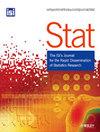马尔可夫转换时空 ARCH 模型
IF 0.8
4区 数学
Q3 STATISTICS & PROBABILITY
引用次数: 0
摘要
股票市场指数本质上是波动的,众所周知,突发性冲击会影响波动模式。自回归条件异方差模型(ARCH)和广义自回归条件异方差模型(GARCH)忽视了突发性冲击引发的结构性断裂,这可能会导致对持续性的高估,造成估计值的向上偏差。为了对金融时间序列数据的波动性进行建模,我们开发了不同的制度转换模型,这些模型具有由马尔科夫链控制的突然制度转换。波动模型也被扩展到空间上相互关联的时间序列,从而产生了 ARCH 模型的空间变体。这启发我们提出了时空对数-ARCH 模型的马尔可夫转换框架。在本文中,我们讨论了该模型的马尔可夫切换扩展、估计过程和平稳推断制度。蒙特卡罗模拟研究表明,我们提出的模型的最大似然估计方法具有良好的有限样本特性。将提出的模型应用于推测受 2015-2016 年中国股灾影响的 28 个股指数据。结果表明,我们的模型比一制度对应模型的拟合效果更好。此外,对数据的平滑推断表明了结构性断裂发生的大致时期。该模型可以捕捉到在附近地点同时发生的结构性断裂。本文章由计算机程序翻译,如有差异,请以英文原文为准。
A Markov‐switching spatio‐temporal ARCH model
Stock market indices are volatile by nature, and sudden shocks are known to affect volatility patterns. The autoregressive conditional heteroskedasticity (ARCH) and generalized ARCH (GARCH) models neglect structural breaks triggered by sudden shocks that may lead to an overestimation of persistence, causing an upward bias in the estimates. Different regime‐switching models that have abrupt regime‐switching governed by a Markov chain were developed to model volatility in financial time series data. Volatility modelling was also extended to spatially interconnected time series, resulting in spatial variants of ARCH models. This inspired us to propose a Markov switching framework of the spatio‐temporal log‐ARCH model. In this article, we discuss the Markov‐switching extension of the model, the estimation procedure and the smooth inferences of the regimes. The Monte Carlo simulation studies show that the maximum likelihood estimation method for our proposed model has good finite sample properties. The proposed model was applied to 28 stock indices' data that were presumably affected by the 2015–2016 Chinese stock market crash. The results showed that our model is a better fit compared to that of the one‐regime counterpart. Furthermore, the smoothed inference of the data indicated the approximate periods where structural breaks occurred. This model can capture structural breaks that simultaneously occur in nearby locations.
求助全文
通过发布文献求助,成功后即可免费获取论文全文。
去求助
来源期刊

Stat
Decision Sciences-Statistics, Probability and Uncertainty
CiteScore
1.10
自引率
0.00%
发文量
85
期刊介绍:
Stat is an innovative electronic journal for the rapid publication of novel and topical research results, publishing compact articles of the highest quality in all areas of statistical endeavour. Its purpose is to provide a means of rapid sharing of important new theoretical, methodological and applied research. Stat is a joint venture between the International Statistical Institute and Wiley-Blackwell.
Stat is characterised by:
• Speed - a high-quality review process that aims to reach a decision within 20 days of submission.
• Concision - a maximum article length of 10 pages of text, not including references.
• Supporting materials - inclusion of electronic supporting materials including graphs, video, software, data and images.
• Scope - addresses all areas of statistics and interdisciplinary areas.
Stat is a scientific journal for the international community of statisticians and researchers and practitioners in allied quantitative disciplines.
 求助内容:
求助内容: 应助结果提醒方式:
应助结果提醒方式:


